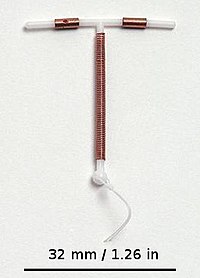
Photo from wikipedia
Abstract This study aimed to evaluate the effect of a levonorgestrel-releasing intrauterine system (LNG-IUS) on the sexual function of women. Participants who had abnormal uterine bleeding (AUB) complaints with LNG-IUSs… Click to show full abstract
Abstract This study aimed to evaluate the effect of a levonorgestrel-releasing intrauterine system (LNG-IUS) on the sexual function of women. Participants who had abnormal uterine bleeding (AUB) complaints with LNG-IUSs were included (study registration: Kanuni Sultan Suleyman Training and Research Hospital, 2018/10/34). The demographic data of all participants were recorded. The female sexual function index (FSFI) questionnaire was used to participants before the insertion of LNG-IUSs and 6 months after its insertion. FSFI scores were calculated at both timepoints and were compared. The total FSFI score after LNG-IUS insertion was significantly higher than the total FSFI score application (p < .001). The scores of the desire, arousal, lubrication, orgasm, satisfaction and pain categories significantly increased after LNG-IUS compared to those before LNG-IUS. As a result, the present study demonstrated that after LNG-IUS insertion, these women had higher FSFI scores. Impact Statement What is already known on this subject? There are many publications in the literature comparing the effects of LNG-IUSs, IUSs, OCs and other contraceptive methods on female sexuality. However, there are markedly few studies that compare sexual function before and after LNG-IUS insertion. What do the results of this study add? The total FSFI score after LNG-IUS insertion was significantly higher than the total FSFI score before the insertion (p < .001). The scores of the desire, arousal, lubrication, orgasm, satisfaction and pain categories significantly increased after LNG-IUS insertion compared to those before the application. The number of participants with FSFI scores ≥26.5 before LNG-IUS insertion was 17 (12.5%), and this number increased to 71 (52.5%) after the application What are the implications of these findings for clinical practice and/or further research? This study contributes to the literature because there are few researches that compare sexual function before and after LNG-IUS insertion. As a result of our study, sexual dysfunction decreased after LNG-IUS, and the scores increased in all sub-groups together with the total FSFI scores.
Journal Title: Journal of Obstetrics and Gynaecology
Year Published: 2020
Link to full text (if available)
Share on Social Media: Sign Up to like & get
recommendations!